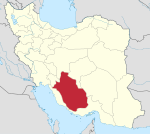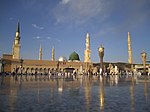Contents
Shah Cheragh (Persian: شاه چراغ) is a 12th century funerary monument and religious complex located in Shiraz, Iran. It is centred around the mausoleum of Sayyid Ahmad, the son of Musa al-Kazim, who is known as Shah Cheragh (King of the Light) in local traditions, and hence the building is named as such. The site is the 363rd national monument of Iran.[1][2][3][4]
History
The first structure over the grave of Sayyid Ahmad ibn Musa was built in the 13th century during the rule of the Salghurids, by the minister, a former Buyid prince.[2] He built a domed mausoleum over the grave and a porch. Local folklore tells that the grave was found when a light appeared over it, which caught the attention of the people, who told the minister about what they had seen.[2] The mausoleum stayed in that state for several years until the rule of the Injuids.[2] During that time, female Injuid monarch, Queen Tash Khatun, further expanded the structure.[1]
During Safavid rule in the 16th century, the building was extensively renovated.[2] Then in the 18th century, Nader Shah Afshar donated a golden chandelier, which was hung under the dome.[4] But a few years later, an earthquake struck Shiraz, and the complex of Shah Cheragh was heavily damaged by the tremors. The golden chandelier was lost during this time. But a year after the earthquake had passed, a man named Qandeel found some remains of the donated gold, which he used to fund the reconstruction of the Shah Cheragh funerary monument.[3]
During the Qajar period, several repairs were made to the building.[4] A silver zarih was also installed around the grave.[4]
Architecture
The religious complex consists of a mosque and the mausoleum of Sayyid Ahmad.[2][4] A museum for ancient works is also situated in the complex.

The mausoleum of Sayyid Ahmad is topped by a large dome. The mausoleum itself is made of plaster and stone. Around his grave, a silver zarih is visible.[4]

The dome over the mausoleum contains a lot of mirror work on the interior.[4] It is a Qajar period construction as well, and it replaces the original Safavid era dome which was destroyed in the earthquake.[4] It has a metal skeleton as well. Persian calligraphy lines the base of the dome.[4]

Museum
The museum located within the Shah Cheragh complex was established in 1925 in a corner of the shrine.[4] In this museum, at least 600 pieces of pottery and clay artwork are stored, as well as several coins from the Parthian and Sassanian periods.[4] Also inside the museum are weapons (such as swords) from the Safavid and Qajar periods.[4] Several examples of manuscripts and documents are archived in there as well.[4]
2022 shooting
On 26 October 2022, at least 15 people were killed in a mass shooting at the complex of Shah Cheragh.[5] The three attackers are described by Iranian state media as apparently being takfiri terrorists. Two attackers have been arrested; the other is at large. Later the same day, Islamic State claimed responsibility for the attack.[6] The Iranian authorities said that the attackers are not Iranian nationals.[7] Iranian semi-official Tasnim news agency stated that children are among the dead.[7] The United Nations have condemned the attack on the religious site.[8]
Gallery
-
Shah Cheragh at night
-
The dome of Shah Cheragh
-
The prayer hall of the mosque in the Shah Cheragh complex
-
The tomb of Mir Muhammad in the mausoleum
-
Tomb of Queen Tash Khatun in the southern side of the complex
See also
References
- ^ a b "چرا به امامزاده احمدبن موسی شاهچراغ در شیراز، شاه چراغ می گویند؟". www.beytoote.com. Retrieved 26 November 2023.
- ^ a b c d e f "چرا به امامزاده احمدبن موسی شاهچراغ در شیراز، شاه چراغ می گویند؟". www.beytoote.com. Retrieved 26 November 2023.
- ^ a b "حرم شاهچراغ (ع): معرفی حرم امامزاده احمد بن موسی + تاریخچه و آدرس". ایرانگرد (in Persian). Retrieved 26 November 2023.
- ^ a b c d e f g h i j k l m https://www.eligasht.com/Blog/travelguide/%D8%A2%D8%B1%D8%A7%D9%85%DA%AF%D8%A7%D9%87-%D8%B4%D8%A7%D9%87-%DA%86%D8%B1%D8%A7%D8%BA/amp/
- ^ "Fifteen killed in attack on Shia mausoleum in southern Iran". BBC News. 27 October 2022. Retrieved 27 October 2022.
- ^ "Attack on Shiraz shrine kills 15: Iranian state media". www.aljazeera.com. Retrieved 27 October 2022.
- ^ a b "Iran: gunmen kill at least 15 people at Shia shrine in Shiraz". the Guardian. 26 October 2022. Retrieved 27 October 2022.
- ^ "UN condemns Shiraz terrorist attack". IRNA English. 26 October 2022. Retrieved 27 October 2022.











